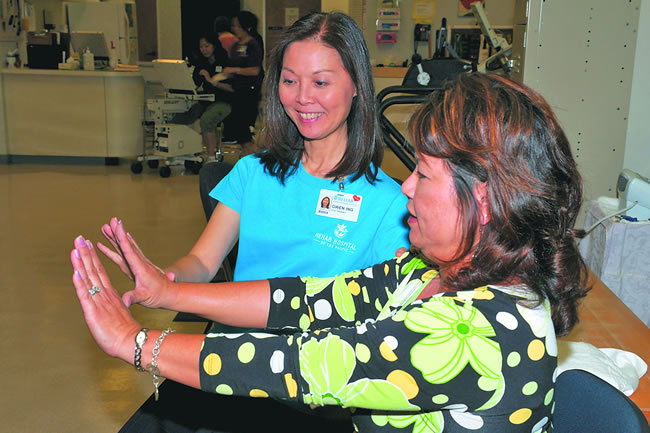Lending A Hand In Therapy
Gwen Ing
Clinic Manager at REHAB in Aiea
Interviewed By Rasa Fournier
Where did you receive your schooling and training?
I went to the University of Washington in Seattle.
How long have you been with REHAB?
Twenty-plus years.
Occupational therapist Gwen Ing
As an occupational therapist, is there any particular ailment you’re seeing more of lately?
I specialize in hand therapy and also treat neurologically impaired patients. One of the common disorders we have been seeing in our clinic is carpal tunnel syndrome. It is also one of the most common surgeries performed by hand surgeons. Data shows that it could affect up to 3 percent of the population.
Does increased computer use and technology contribute to the problem?
That would be one of the causes. Carpal tunnel syndrome occurs when the median nerve becomes compressed at the wrist. The median nerve is responsible for sensation to your thumb, index and middle fingers, and sometimes part of the ring finger. There is also a motor component responsible for movement of certain muscles in the hand. The nerve can become compressed during work or leisure activities involving excessive force or repetitive movement at the wrist.
Someone who uses tools or computers constantly might be more susceptible, or someone who is exposed to vibration, for instance use of jackhammers or drills.
The tunnel is made up of the wrist bones on the bottom and a thick fibrous band at the top, so the tunnel is very non-elastic. There are nine tendons in addition to the median nerve that go through the carpal tunnel so there isn’t a lot of space in the tunnel. If the tunnel becomes swollen, it will affect the nerve’s ability to function normally. In surgery, they often clip the fibrous band to release some of the pressure in the tunnel. The symptoms are relieved in most cases and complications are usually minimal.
What treatment is available for carpal tunnel syndrome?
The occupational therapist would first do an assessment with the patient to see what could be affecting compression of the nerve. The goal of therapy is to relieve that compression. We might perform a sensory test and look at what factors could be contributing to the mechanical pressures on the wrist. Sometimes a splint is needed to assist with keeping the wrist in neutral position. We usually provide a home exercise program to improve flexibility at the wrist. We can also make recommendations for modifying activities and postures at home and work to minimize the stress to the tendon system, including setting up the work station or home computer to minimize carpal tunnel symptoms.
After surgery, therapy goals are to decrease pain and swelling and regain hand strength and function for return to normal daily activities.
What other related hand disorders do you treat?
A number of people who have carpal tunnel syndrome might have associated problems such as trigger finger or Dequervain’s, which is a type of tenosynovitis. With trigger finger there might be pain, swelling or clicking at the base of the finger. In Dequervain’s there would be pain or swelling on the thumb side of the wrist. Both of these are compression injuries as well, but they involve tendons instead of the nerve. In both instances, the tendon may become swollen or stuck under a fibrous sheath that it normally passes through smoothly. When the tendon is swollen it won’t glide as well so there might be some locking or sticking and therefore pain. Like carpal tunnel syndrome, it’s the result of repetitive movement, awkward movement or constant forceful gripping or pinching. Similar to carpal tunnel syndrome, we would assess what factors are causing the injury and recommend modifying activities and tools, in addition to setting up a home program, and possibly providing a splint to rest the affected area.
Does carpal tunnel necessitate surgery?
For carpal tunnel, the earlier you catch it the better, because if you learn to modify your environment and activities, you can prevent the symptoms from worsening. If you wait too long, the symptoms will become more aggravated and then surgery could be necessary. In terms of surgery, studies show that 8696 percent of patients who have these surgeries are satisfied after the surgery and find their symptoms relieved. Your physician or hand surgeon would know best if your condition requires surgery.
What are common symptoms of carpal tunnel syndrome and the associated disorders?
Most common symptoms are numbness or tingling in the first three digits and sometimes partially in the fourth digit of the hand, because the median nerve feeds into those areas. Dropping items or difficulty grasping items is also common. The symptoms may become worse at night. Over time, there might be pain at the wrist. With trigger finger, there is pain, clicking or locking in the affected finger. With Dequervain’s, there is pain on the thumb side of the wrist.
Anything else you’d like to mention?
The population we’re seeing is getting younger. People are more exposed to repetitive forces at home and at work with video games, computers and other technology. It forces us to use the smaller muscles of the hand more often. If you find that you’re having any of the symptoms, consult your physician because you want to catch it early. Your occupational therapist can help through education to prevent the symptoms from worsening.







